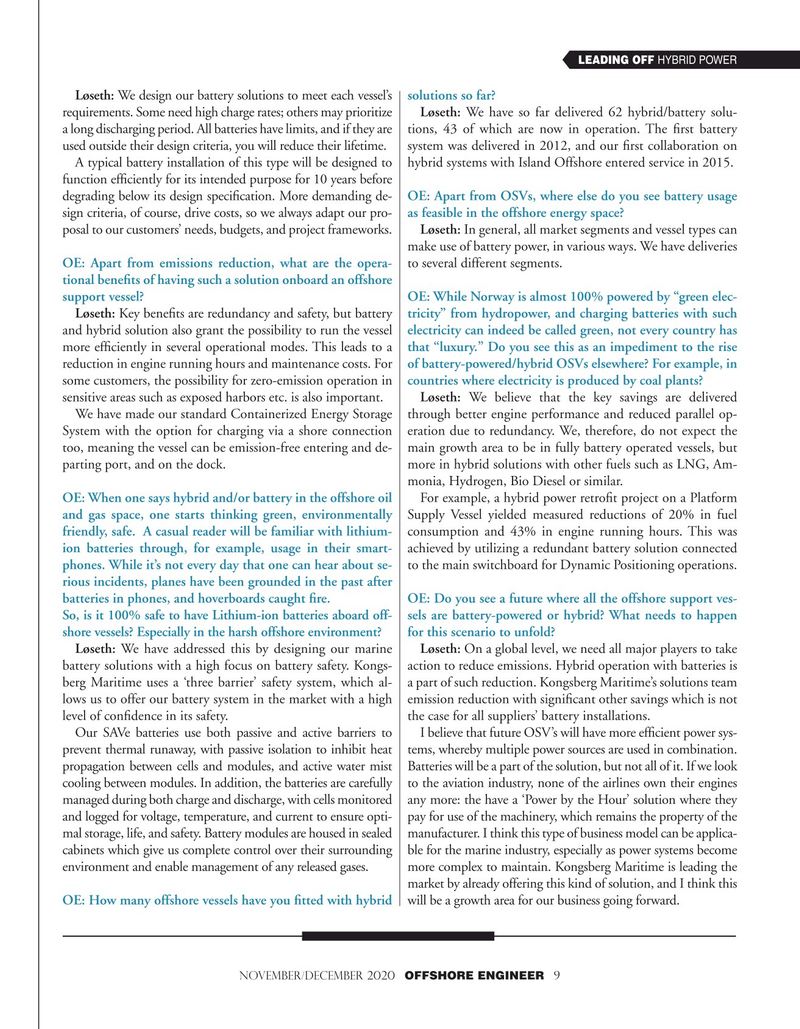
Page 9: of Offshore Engineer Magazine (Nov/Dec 2020)
Read this page in Pdf, Flash or Html5 edition of Nov/Dec 2020 Offshore Engineer Magazine
LEADING OFF HYBRID POWER
Løseth: We design our battery solutions to meet each vessel’s solutions so far? requirements. Some need high charge rates; others may prioritize Løseth: We have so far delivered 62 hybrid/battery solu- a long discharging period. All batteries have limits, and if they are tions, 43 of which are now in operation. The ?rst battery used outside their design criteria, you will reduce their lifetime. system was delivered in 2012, and our ?rst collaboration on
A typical battery installation of this type will be designed to hybrid systems with Island Offshore entered service in 2015.
function ef?ciently for its intended purpose for 10 years before degrading below its design speci?cation. More demanding de- OE: Apart from OSVs, where else do you see battery usage sign criteria, of course, drive costs, so we always adapt our pro- as feasible in the offshore energy space? posal to our customers’ needs, budgets, and project frameworks. Løseth: In general, all market segments and vessel types can make use of battery power, in various ways. We have deliveries
OE: Apart from emissions reduction, what are the opera- to several different segments. tional bene?ts of having such a solution onboard an offshore support vessel? OE: While Norway is almost 100% powered by “green elec-
Løseth: Key bene?ts are redundancy and safety, but battery tricity” from hydropower, and charging batteries with such and hybrid solution also grant the possibility to run the vessel electricity can indeed be called green, not every country has more ef?ciently in several operational modes. This leads to a that “luxury.” Do you see this as an impediment to the rise reduction in engine running hours and maintenance costs. For of battery-powered/hybrid OSVs elsewhere? For example, in some customers, the possibility for zero-emission operation in countries where electricity is produced by coal plants?
sensitive areas such as exposed harbors etc. is also important. Løseth: We believe that the key savings are delivered
We have made our standard Containerized Energy Storage through better engine performance and reduced parallel op-
System with the option for charging via a shore connection eration due to redundancy. We, therefore, do not expect the too, meaning the vessel can be emission-free entering and de- main growth area to be in fully battery operated vessels, but parting port, and on the dock. more in hybrid solutions with other fuels such as LNG, Am- monia, Hydrogen, Bio Diesel or similar.
OE: When one says hybrid and/or battery in the offshore oil For example, a hybrid power retro?t project on a Platform and gas space, one starts thinking green, environmentally Supply Vessel yielded measured reductions of 20% in fuel friendly, safe. A casual reader will be familiar with lithium- consumption and 43% in engine running hours. This was ion batteries through, for example, usage in their smart- achieved by utilizing a redundant battery solution connected phones. While it’s not every day that one can hear about se- to the main switchboard for Dynamic Positioning operations.
rious incidents, planes have been grounded in the past after batteries in phones, and hoverboards caught ?re. OE: Do you see a future where all the offshore support ves-
So, is it 100% safe to have Lithium-ion batteries aboard off- sels are battery-powered or hybrid? What needs to happen shore vessels? Especially in the harsh offshore environment? for this scenario to unfold?
Løseth: We have addressed this by designing our marine Løseth: On a global level, we need all major players to take battery solutions with a high focus on battery safety. Kongs- action to reduce emissions. Hybrid operation with batteries is berg Maritime uses a ‘three barrier’ safety system, which al- a part of such reduction. Kongsberg Maritime’s solutions team lows us to offer our battery system in the market with a high emission reduction with signi?cant other savings which is not level of con?dence in its safety. the case for all suppliers’ battery installations.
Our SAVe batteries use both passive and active barriers to I believe that future OSV’s will have more ef?cient power sys- prevent thermal runaway, with passive isolation to inhibit heat tems, whereby multiple power sources are used in combination. propagation between cells and modules, and active water mist Batteries will be a part of the solution, but not all of it. If we look cooling between modules. In addition, the batteries are carefully to the aviation industry, none of the airlines own their engines managed during both charge and discharge, with cells monitored any more: the have a ‘Power by the Hour’ solution where they and logged for voltage, temperature, and current to ensure opti- pay for use of the machinery, which remains the property of the mal storage, life, and safety. Battery modules are housed in sealed manufacturer. I think this type of business model can be applica- cabinets which give us complete control over their surrounding ble for the marine industry, especially as power systems become environment and enable management of any released gases. more complex to maintain. Kongsberg Maritime is leading the market by already offering this kind of solution, and I think this
OE: How many offshore vessels have you ?tted with hybrid will be a growth area for our business going forward.
NOVEMBER/DECEMBER 2020 OFFSHORE ENGINEER 9

 8
8

 10
10